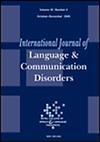Validity and Reliability of the Turkish Version of the Dynamic Evaluation of Motor Speech Skill (DEMSS-TR) Test for Children With Speech Sound Disorders
Abstract
Background
Childhood apraxia of speech (CAS) is a complex motor speech disorder that requires careful differential diagnosis, particularly in languages where validated diagnostic tools are lacking. The Dynamic Evaluation of Motor Speech Skill (DEMSS) is a widely used tool for identifying CAS, but a Turkish version had not yet been developed.
Aims
This study aimed to adapt DEMSS into Turkish (DEMSS-TR) and evaluate its psychometric properties for use with Turkish-speaking children with speech sound disorders (SSD).
Methods
Eighty-two monolingual Turkish-speaking children aged 3;0 to 6;11 with SSDs participated. Participants were assessed for speech-motor skills, oral-motor function, articulation, and language development. Following translation and pilot testing, DEMSS-TR was evaluated for internal consistency, test–retest reliability and intra- and inter-rater reliability. Validity was assessed through expert-based content validation, cluster analysis and receiver operating characteristic (ROC) analysis.
Results
DEMSS-TR demonstrated strong reliability and validity. Cronbach's alpha exceeded 0.90 for all subtests and the total score. Test–retest coefficients ranged from 0.823 to 0.991, with inter- and intra-rater reliability consistently above 0.90. Content validity was supported by expert ratings, with all items exceeding a content validity ratio of 0.80. Cluster analysis revealed three distinct participant groupings consistent with CAS, mild CAS and non-CAS diagnoses. ROC analysis showed high sensitivity and specificity across subtests and total score, confirming the tool's diagnostic accuracy.
Conclusions
DEMSS-TR is a reliable and valid assessment for identifying CAS in Turkish-speaking children with SSDs. Its dynamic, structured format allows clinicians to observe motor speech behaviours under cued and spontaneous conditions, supporting accurate diagnosis and treatment planning. This adaptation addresses a significant gap in Turkish clinical practice and contributes to the international literature on cross-linguistic assessment of motor speech disorders.
WHAT THIS PAPER ADDS
- It is performed with the Dynamic Evaluation of Motor Speech Skills (DEMSS) (Strand et al. 2013; Strand and McCauley 2019), which performs the dynamic evaluation of childhood apraxia of speech (CAS), one of the subtypes of speech sound disorders. Although the original language of the test is English, there are validity and reliability studies in Swedish and Brazilian Portuguese.
- This study represents the first international research on CAS in Turkish, presenting reliability and validity data for the first Turkish CAS assessment tool. Uniquely, the study adhered strictly to the original English DEMSS during its adaptation. Unlike other language studies, this research employed Cluster Analysis, a less common validation method in speech and language impairment scales, providing a valuable guide for future test development or adaptation. Additionally, it highlights the importance of dynamic evaluation in the field of motor speech disorders, demonstrating its practical application.
- This study holds significant clinical implications, particularly in improving the accuracy and standardisation of motor speech assessments for Turkish-speaking children. By validating this tool, clinicians can more precisely diagnose and tailor treatment plans for individuals with motor speech disorders, especially CAS, ensuring that interventions are both culturally and linguistically appropriate. This advancement not only enhances the consistency of assessments across different clinical settings but also contributes to more effective and individualised speech therapy, ultimately leading to better patient outcomes.

 求助内容:
求助内容: 应助结果提醒方式:
应助结果提醒方式:


